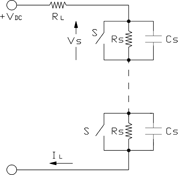Considerations for series connection of IGBT and MOSFET switches
28 May 2008
Power Electronics / Power Management
Information from Ixys
Figure 1 shows the typical RC snubber networks for voltage sharing for switches (S) connected in series in a capacitive discharge circuit. A static voltage sharing resistor RS is required so that the switch with the lowest leakage current is not forced into avalanche and a dynamic voltage sharing capacitor CS is needed so that the slowest switch is not forced into avalanche voltage breakdown during turn-on. A compromise must be reached between the number of switches in series, values for RS and CS and cost of the total switch.
The values of the resistors RS and capacitors CS can be computed from the following:
1. Static voltage sharing resistor RS:
RS ≤ (nVS(MAX) – VDC)(n – 1)-1 IS-1
where: n = number of devices in series
VS(MAX) = maximum allowable voltage across a switch (normally 80% of the maximum switch voltage rating)
IS = maximum leakage current of a switch.
Power dissipation in resistor RS:
2. Dynamic voltage sharing capacitor CS: Assuming no reverse current flow through the switches, then the major factor to consider in sizing capacitor CS is the voltage buildup on the last switch to turn-on. It is desirable to prevent the MOSFET from avalanching in order to limit its turn-on losses. The worst case scenario is that the switch sustaining the highest voltage is also the slowest to turn on.
Then:
where: ΔV = Avalanche voltage - VS(MAX)
DtD(ON) = difference in turn-on times
Solving for CS:
Further reading:
Power MOSFET in a PowerFLAT package
Future Electronics
Power Electronics / Power Management
The ST8L60N065DM9 from STMicroelectronics is a 600 V N-channel Super-Junction power MOSFET that offers excellent performance in a compact surface-mount package.
Read more...
High-density planar power for mission-critical systems
NuVision Electronics
Power Electronics / Power Management
Vishay’s SGTPL-28 family of planar transformers offer 150 W of output power from a 28 V input forward-converter architecture.
Read more...
Microlens to increase solar panel efficiency
Power Electronics / Power Management
Researchers at the Fraunhofer ISE have recently developed a novel micro-concentrated photovoltaic module that achieves higher efficiency and reduced production costs.
Read more...
Rugged PSU for challenging conditions
Conical Technologies
Power Electronics / Power Management
Built for rugged reliability, the Mibbo MFC Series delivers stable, efficient power in environments where moisture, dust, and temperature extremes are everyday challenges.
Read more...
How dispatchable power and grid readiness are redefining the global landscape
Power Electronics / Power Management
No longer defined by megawatt capacity alone, solar projects are now being evaluated on their ability to deliver dispatchable power, enhance grid stability, and provide critical ancillary services.
Read more...
ABB’s Mission to Zero drives South Africa’s energy transition
ABB Electrification Products
Power Electronics / Power Management
ABB Electrification is charting a bold path towards a net-zero future with its Mission to Zero programme, a blueprint that combines energy efficiency, electrification, and digital innovation to accelerate the transition to clean energy.
Read more...
Energy harvesting using a battery-less IoT system
NuVision Electronics
Editor's Choice Power Electronics / Power Management
Energy Harvesting plays an essential role in the foundation of ambient IoT, a new generation of ultra-low power connected devices that operate by drawing energy from their environment instead of relying on traditional batteries.
Read more...
Driving power, defining performance
Future Electronics
Power Electronics / Power Management
Vishay’s portfolio of inductors, current sense resistors, and MOSFETs provides a comprehensive solution for intelligent power management.
Read more...
Battery simulator module simplifies BMS testing
Test Dynamics
Power Electronics / Power Management
The PXI/PXIe solution from Pickering Interfaces offers a scalable, modular design for faster development cycles, lower total cost of ownership, and improved safety.
Read more...
DC PSU: The cornerstone for efficient solar-storage systems
Vepac Electronics
Power Electronics / Power Management
PV energy storage systems are evolving and DC power supplies, with their technical characteristics that are naturally compatible with new energy, have become a key carrier for improving system energy efficiency.
Read more...


